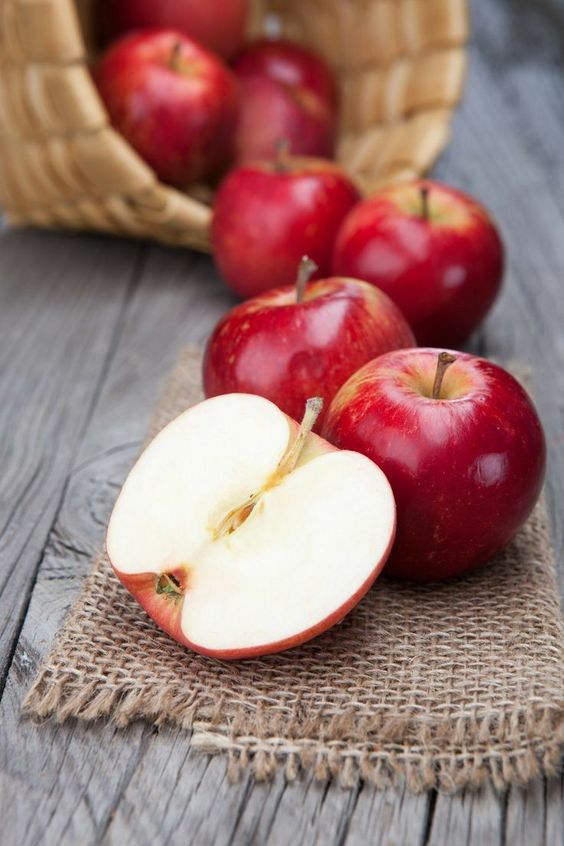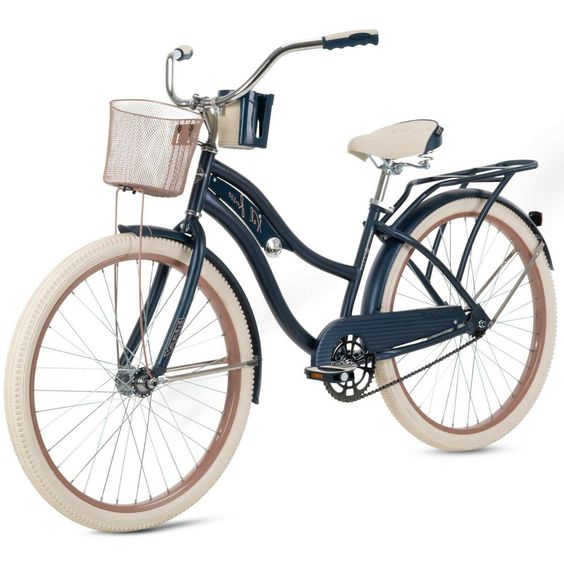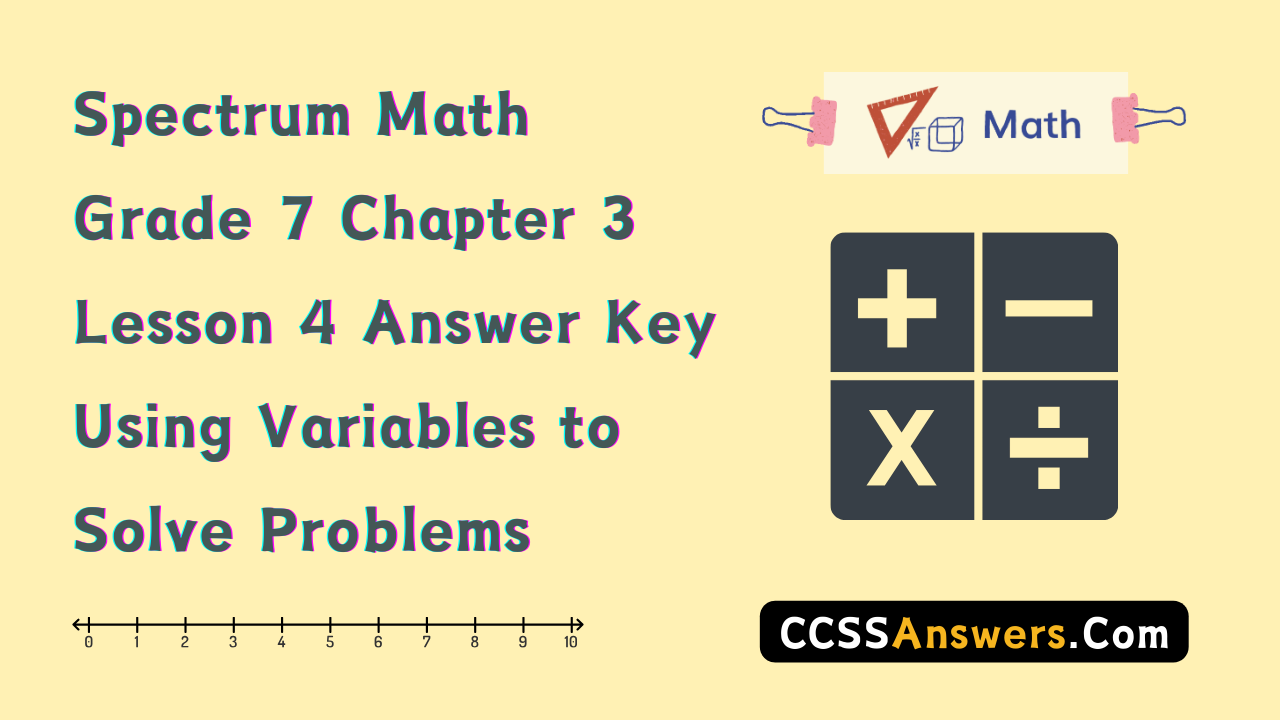This handy Spectrum Math Grade 7 Answer Key Chapter 3 Lesson 3.4 Using Variables to Solve Problems provides detailed answers for the workbook questions.
Spectrum Math Grade 7 Chapter 3 Lesson 3.4 Using Variables to Solve Problems Answers Key
Write an equation to represent the problem, using the variable n for the unknown number. Then, solve for the value of the variable. Look at the following problem as an example.
George and Cindy are saving for bicycles. Cindy has saved $ 15 less than twice as much as George has saved. Together, they have saved $ I 20, How much did each of them save?
Let n stand for the amount George has saved. What stands for the amount Cindy has saved? 2n – 15 What equals the total amount? n + (2n – 15) = 120 Simplify: 3n – 15 = 120 Solve.
How much has George saved? $45
How much has Cindy saved? $75
Solve each problem.
Question 1.
Nate and Laura picked apples. Laura picked 5 as many as Nate picked. Together they picked 90 apples. How many did each of them pick?

Let n stand for the number Nate picked.
Equation: _____________
How many apples did Nate pick? ______________
How many apples did Laura pick? ____________
Answer: Equation: 5n + n = 90
How many apples did Nate pick? 15
How many apples did Laura pick? 75
Let n stand for the number Nate picked.
According to the question, number of apples picked by Laura = 5n
Together they picked 90 apples. So, 5n + n = 90
6n = 90
n = \(\frac{90}{6}\)
n = 15
Therefore, number of apples picked by Nate = 15
and, number of apples picked by Laura = 5 × 15 = 75
Question 2.
Jordan travels \(\frac{3}{4}\) of a mile longer to school each day than Harrison does. Combined, they travel 5\(\frac{1}{4}\) miles to school. How far does each travel?
Let n stand for the distance Jordan travels.
Equation: n – \(\frac{3}{4}\) + n = 5\(\frac{1}{4}\)
How far does Jordan travel?3 miles
How far does Harrison travel?2\(\frac{1}{4}\) miles
Answer: Equation: _____________
How far does Jordan travel? _____________
How far does Harrison travel?
Jordan travels \(\frac{3}{4}\) of a mile longer to school each day than Harrison does.
Let n stand for the distance Jordan travels.
and distance Harrison travels = n – \(\frac{3}{4}\)
Together they travelled 5\(\frac{1}{4}\) miles to school.
n – \(\frac{3}{4}\) + n = 5\(\frac{1}{4}\)
5\(\frac{1}{4}\) converting this into improper fraction. Then, it becomes \(\frac{21}{4}\)
2n – \(\frac{3}{4}\) = \(\frac{21}{4}\)
2n = \(\frac{21}{4}\) + \(\frac{3}{4}\)
2n = \(\frac{21 + 3}{4}\)
2n = \(\frac{24}{4}\)
2n = \(\frac{6}{1}\)
So, n = 3 miles
Therefore, Jorden travels = 3 miles
Harrison travels = 3 – \(\frac{3}{4}\)
= \(\frac{12 – 3}{4}\)
= \(\frac{9}{4}\)
= 2\(\frac{1}{4}\) miles
Question 3.
Two jackets have a combined cost of $98. Jacket A costs $ 12 less than Jacket B. How much does each jacket cost?
Let n stand for the cost of Jacket A.
Equation: __________
Jacket A costs ____________
Jacket B costs __________
Answer: Equation: n + n + $ 12 = $98
Jacket A costs = $43
Jacket B costs = $55
Let n stand for the cost of Jacket A.
Jacket A costs $ 12 less than Jacket B
So, the cost of jacket B = n + $ 12
Two jackets have a combined cost of $98
Therefore, n + n + $ 12 = $98
2n + $12 = $98
2n =$98 – $12
2n = $86
n = \(\frac{$86}{2}\)
n = $43
Therefore, the cost of jacket A = $43
and , the cost of jacket B = $43 + $12 = $55
Solve each problem.
Question 1.
William purchased a new car. The total price he will pay for the car, including interest, is $ 17,880. If he splits his car payments over 60 months, how much will he pay each month?

Let p represent each payment.
Equation: __________
William will pay _____ each month.
Answer: Equation: p =\(\frac{$ 17,880}{60}\)
William will pay $ 298 each month.
The total price he will pay for the car, including interest, is $ 17,880.
Duration of car payments = 60 months
Let p represent each payment.
So, payment done by William each month can be given as total price divided by number of months, which is p =\(\frac{$ 17,880}{60}\)
After simplification, by dividing 17880 with 60, it becomes, p = $ 298.
So, William pays $ 298 every month.
Question 2.
Tracy has $ 1.55 in quarters and dimes. If she has 3 quarters, how many dimes does she have?
Let d represent the number of dimes.
Equation: __________
Tracy has _____ dimes.
Answer: Equation:3 × 25 + d × 10 = 155
Tracy has 8 dimes.
Tracy has $ 1.55 in quarters and dimes.
1 quarter = 25 cents
1 dime = 10 cents
Tracy has 3 quarters
Let d represent the number of dimes.
Therefore, 3 × 25 + d × 10 = 155 (as 1.55 dollars = 155 cents)
75 + 10d = 155
10d = 155 – 75
10d = 80
d = \(\frac{80}{10}\)
d = 8
Therefore, number of dimes Tracy as 8
Question 3.
Kavon is saving money to buy a bicycle that costs $ 150. He has been saving his $5 weekly allowance for the last 8 weeks and he saved $50 from his birthday money. How much more money does Kavon need to buy his bicycle?

Let m represent the money Kavon needs.
Equation: ___________
Kavon needs __________
Answer: Equation: m + $90 = $150
Kavon needs $60
Kavon is saving money to buy a bicycle that costs $ 150.
He has been saving his $5 weekly allowance for the last 8 weeks and he saved $50 from his birthday money.
So, total money he has right now = $5 × 8 + $50 = $40 + $50 = $90
Let m represent the money Kavon needs.
The more money Kavon needs to buy his bicycle = m + $90 = $150
m = $150 – $90
m = $60
Therefore, Kavon needs $60 more to buy his bicycle
Question 4.
Lincoln Middle School won their football game last week by scoring 23 points. If they scored two 7-point touchdowns, how many 3-point field goals did they score?
Let f represent the number of field goals.
Equation: ___________
They scored ________ field goals.
Answer: Equation: 2 × 7 + 3 × f = 23
They scored 3 field goals.
Lincoln Middle School won their football game last week by scoring 23 points.
They scored two 7-point touchdowns an we need to find the number of 3-point field goals
Let f represent the number of field goals.
So, number of field goals = 2 × 7 + 3 × f = 23
14 + 3f = 23
3f = 23 – 14
3f = 9
Hence, f = 3
Therefore, they have scored 3 3-point field goals
Question 5.
Walker is reading a book that is 792 pages. He reads 15 pages a day during the week, and 25 pages a day during the weekend. After 5 weeks of reading, how many pages does Walker still have left to read before he finishes the book?
Let r represent the pages left to read.
Equation: __________
Walker has _____ pages left to read.
Answer: Equation: r + 625 = 792
Walker has 167 pages left to read.
Walker is reading a book that is 792 pages.
He reads 15 pages a day during the week, and 25 pages a day during the weekend. So, he reads 15 × 5 + 25 × 2 pages in a week, which is 125 pages
After 5 weeks of reading, number of pages he completed = 5 × 125 = 625 pages
Let r represent the pages left to read.
Therefore, number of pages left by Walker to read = r + 625 = 792
r = 792 – 625
r = 167 pages
Solve each problem.
Question 1.
Peaches are on sale at the farmer’s market for $ 1.75 per pound. If Ida buys $8.75 worth of peaches, how many pounds of peaches did she buy?

Let p represent pounds of peaches.
Equation: ___________
Ida bought ____ pounds of peaches.
Answer: Equation: p × $ 1.75 = $8.75
Ida bought 5 pounds of peaches.
Peaches are on sale at the farmer’s market for $ 1.75 per pound.
Ida bought $8.75 worth of peaches
Let p represent pounds of peaches.
Number of pounds of peaches she bought = p × $ 1.75 = $8.75
p = \(\frac{$8.75}{$ 1.75}\)
After simplifying the above statement,
p = 5
Therefore, She bought 5 pounds of peaches
Question 2.
Kylie makes $8.50 an hour working at a restaurant. If she brings home $ 170 in her paycheck, how many hours did she work?
Let h represent the number of hours Kylie works.
Equation: h × $8.50 = $ 170
Kylie worked 20 hours.
Answer: Equation: ____________
Kylie worked _____ hours.
Kylie makes $8.50 an hour working at a restaurant.
she brings home $ 170 in her paycheck
Let h represent the number of hours Kylie works
Number of hours she worked = h × $8.50 = $ 170
h = \(\frac{ $ 170}{$8.50}\)
After simplifying the above statement,
h = 20 hours
Therefore, she worked for 20 hours
Question 3.
Larry and 3 friends went to a basketball game. They Daid $5.00 for each of their tickets and each bought a Dag of candy. If they spent a total of $28, how much was each bag of candy?
Let c represent bags of candy.
Equation: __________
Each bag of candy cost _____.
Answer: Equation: $20.00 + 4 × c = $28.00
Each bag of candy cost $2.00
Larry and 3 friends went to a basketball game.
They Paid $5.00 for each of their tickets
So, amount they spent on tickets = $5.00 × 4 = $20.00
They spent total of $28.00
Let c represent bags of candy.
Cost of each candy bag = $20.00 + 4 × c = $28.00
4c = $28.00 – $20.00
4c = $8.00
c = \(\frac{ $8.00}{4}\)
c = $2
Question 4.
Three hoses are connected end to end. The first hose is 6.25 feet. The second hose is 6.5 feet. If the length of all 3 hoses when connected is 20 feet, how long is the third hose?
Let h represent the length of the third hose.
Equation: _________
The third hose is ____ feet long.
Answer: Equation: 6.25 + 6.5 +h = 20
The third hose is 7.25 feet long.
Three hoses are connected end to end.
The first hose is 6.25 feet. The second hose is 6.5 feet.
the length of all 3 hoses when connected is 20 feet
Let h represent the length of the third hose.
Therefore, the length of third hose = 6.25 + 6.5 +h = 20
12.75 + h = 20
h = 20 – 12.75
h = 7.25
So, the length of third hose = 7.25 feet
Question 5.
Quinn and her mom went to the movies. They paid $ 10.50 for each of their tickets and each bought
a tub of popcorn. If they spent a total of $38.50, how much was each tub of popcorn?
Let p represent tubs of popcorn.
Equation: _____________
Each tub of popcorn cost ______.
Answer: Equation: $ 21 + 2 × p = $38.50
Each tub of popcorn cost $8.75
Quinn and her mom went to the movies.
They paid $ 10.50 for each of their tickets and each bought a tub of popcorn.
The amount they spent on their tickets = 2 × $ 10.50 = $ 21
They spent total amount of $38.50
Let p represent tubs of popcorn.
Cost of each tub of popcorn = $ 21 + 2 × p = $38.50
2p = $38.50 – $21
2p = $17.50
p = \(\frac{ $17.50}{2}\)
p = $8.75
Therefore, each tub of popcorn costs $8.75
